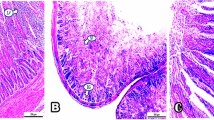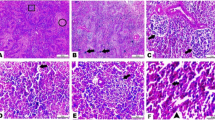Abstract
The present study was undertaken for the production of encapsulated zinc and its evaluation in broiler chicken diet. The process of microencapsulation involved the use of polymers, gum arabic and maltodextrin with a maximum encapsulation of efficiency of 66%. Encapsulated material contained about 20% zinc oxide (ZnO) as core material following the freeze-drying process. One hundred and ninety-two-day-old broiler chicks were distributed in four groups in six replications having eight birds in each. The four groups comprised control (inorganic source of zinc), En-Zn-100 (encapsulated zinc at 100% of control), En-Zn-50 (encapsulated zinc at 50% of control), and Org-Zn-50 (Zn-methionine at 50% of control). The experiment was carried out for 35 days following standard management practices. The live weight gain, feed intake and FCR were comparable among groups. Plasma and muscle zinc (ppm) content was unaffected by the level or source of zinc supplementation. The zinc apparent ileal digestibility coefficient was significantly (P < 0.05) higher in En-Zn-50 fed groups, while crude protein digestibility was not affected by the level or form of Zn supplementation. Bone weight, length, and zinc content were comparable, and bone ash content was significantly different among the groups. Relative expression of ZnT2 was significantly upregulated in encapsulated zinc-fed groups. From the study, it could be concluded that supplementation of zinc either as encapsulated or organic form at 50% of inorganic source (ZnO) could be sufficient to maintain the growth performance, serum, tissue and bone mineral content in broiler chicken.





Similar content being viewed by others
References
Swain PS, Rao SBN, Rajendran D, Dominic G, Selvaraju S (2016) Nano zinc an alternative to conventional zinc as animal feed supplement: a review. Anim Nutr 2:134–141. https://doi.org/10.1016/j.aninu.2016.06.003
Swain PS, Rao SBN, Rajendran D, Pal DT, Mondal S, Selvaraju S (2018) Effect of supplementation of nano zinc oxide on nutrient retention, organ and serum minerals profile, and hepatic metallothionein gene expression in Wister albino rats. Biol Trace Elem Res 190:76–86. https://doi.org/10.1007/s12011-018-1517-5
Swain PS, Rao SB, Rajendran D, Krishnamoorthy P, Mondal S, Pal DT, Selvaraju S (2021) Nano zinc supplementation in goat (Capra hircus) ration improves immunity, serum zinc profile and IGF-1 hormones without affecting thyroid hormones. J AnimPhyAnimNutr 105:621–629. https://doi.org/10.1111/jpn.13500
Underwood EJ, Suttle NF (1999) The mineral nutrition of livestock, 3rd edn. CABI Publishing, Wallingford, pp 283–292. https://doi.org/10.1079/9780851991283.0283
National Research Council (1994) Nutrient requirements of poultry, 9th edn. National Academy Press, Washington, DC. https://doi.org/10.17226/2114
Sunder S, Panda G, Gopinath NC, Rama Rao SV, Raju MVLN, Reddy MR (2008) Effects of higher levels of zinc supplementation on performance, mineral availability and immune competence I broiler chickens. J Appl Poult Res 17:79–86. https://doi.org/10.3382/japr.2007-00029
Feng J, Ma W, Niu H, Wu X, Wang Y (2010) Effects of zinc glycine chelate on growth, hematological, and immunological characteristics in broilers. Biol Trace Elem Res 133:203–211. https://doi.org/10.1007/s12011-009-8431-9
Fordyce EJ, Forbes RM, Robbins KR, Erdman JW (1987) Phytate × calcium/zinc molar ratios: are they predictive of zinc bioavailability? Food Sci 52(2):440–444. https://doi.org/10.1111/j.1365-2621.1987.tb06634.x
Moharreri M, Vakili R, Oskoueian E, Rajabzadeh G (2022) Effects of microencapsulated essential oils on growth performance and biomarkers of inflammation in broiler chickens challenged with Salmonella enteritidis. J Saudi Soc Agr Sci 21:349–357. https://doi.org/10.1016/j.jssas.2021.10.012
Rajendran D, Ezhuthupurakkal PB, Lakshman R, Gowda NKS, Manimaran A, Rao SBN (2022) Application of encapsulated nano materials as feed additive in livestock and poultry: a review. Vet Res Commun 46:315–328. https://doi.org/10.1007/s11259-022-09895-7
Grilli E, Tugnoli B, Vitari F, Domeneghini C, Morlacchini M, Piva A, Prandini A (2015) Low doses of microencapsulated zinc oxide improve performance and modulate the ileum architecture, inflammatory cytokines and tight junctions expression of weaned pigs. Animal 9:1760–1768. https://doi.org/10.1017/S1751731115001329
Lu WB, Kuang YG, Ma ZX, Liu YG (2020) The effect of feeding broiler with inorganic, organic, and coated trace minerals on performance, economics, and retention of copper and zinc. J Appl Poult Res 29:1084–1090. https://doi.org/10.1016/j.japr.2020.10.002
Abbasi S, Azari S (2011) Efficiency of novel iron microencapsulation techniques: fortification of milk. Int J Food Sci Techn 46:1927–1933. https://doi.org/10.1111/j.1365-2621.2011.02703.x
AOAC (1995) Official methods of analysis. In: Association of Official Analytical Chemist, 16th edn. Benjamin Frankin Station, Washington, D.C
He B, Bortoluzzi C, King WD, Graugnard D, Dawson KA, Applegate TJ (2019) Zinc source influences the gene expression of zinc transporters in jejunum and cecal tonsils during broiler challenge with Eimeria maxima and Clostridium perfringens. Poult Sci 98(3):1146–1152. https://doi.org/10.3382/ps/pey484
Sun XM, Liao XD, Lin LU, Zhang LY, Lin XI, Luo XG (2019) Effect of in ovo zinc injection on the embryonic development, tissue zinc contents, antioxidation, and related gene expressions of broiler breeder eggs. J Integrat Agr 17(3):648–656. https://doi.org/10.1016/S2095-3119(17)61704-0
Tukey JW (1957) Variances of variance components. III. Third moments in a balanced single classification. Ann Math Stat 28:378–384
Ramirez S, Lu WB, Davin R, van der Broek H, Liu YG (2022) Effect of encapsulated trace minerals premix in comparison with inorganic and organic microminerals on growth performance and mineral excretion of broiler. J Food Sci Nutr Res 5(1):341–350. https://doi.org/10.26502/jfsnr.2642-11000085
Rossi P, Rutz F, Anciuti MA, Rech JL, Zauk NH (2007) Influence of graded levels of organic zinc on growth performance and carcass traits of broilers. J of Appl Poult Res 16(2):219–225. https://doi.org/10.1093/japr/16.2.219
Jose N, Elangovan AV, Awachat VB, Shet D, Ghosh J, David CG (2018) Response of in ovo administration of zinc on egg hatchability and immune response of commercial broiler chicken. J Anim Physiol Anim Nutr 102(2):591–595. https://doi.org/10.1111/jpn.12777
Salim HM, Lee HR, Jo C, Lee SK, Lee BD (2011) Supplementation of graded levels of organic zinc in the diets of female broilers: effects on performance and carcass quality. Br Poult Sci 52(5):606–612. https://doi.org/10.1080/00071668.2011.616485
Long L, Zhao X, Li H, Yan X, Zhang H (2022) Effects of zinc lactate supplementation on growth performance, intestinal morphology, serum parameters, and hepatic metallothionein of Chinese yellow-feathered broilers. Biol Trace Elem Res 200:1835–1843. https://doi.org/10.1007/s12011-021-02785-0
Zhu X, Shang X, Lin G, Li H, Feng X, Zhang H (2022) Effects of zinc glycinate on growth performance, serum biochemical indexes, and intestinal morphology of yellow feather broilers. Biol Trace Elem Res 200:4089–4097. https://doi.org/10.1007/s12011-021-02990-x
Ao T, Pierce JL, Pescatore AJ, Cantor AH, Dawson KA, Ford MJ, Paul M (2011) Effects of feeding different concentration and forms of zinc on the performance and tissue mineral status of broiler chicks. British Poult Sci 52:466–471. https://doi.org/10.1080/00071668.2011.588198
Saleh AA, Ragab MM, Ahmed EAM, Abudabos AM, Ebeid TA (2018) Effect of dietary zinc-methionine supplementation on growth performance, nutrient utilization, antioxidative properties and immune response in broiler chickens under high ambient temperature. J Appl Anim Res 46:820–827. https://doi.org/10.1080/09712119.2017.1407768
Li FF, Azad MAK, Li ZH, Li J, Mo KB, Ni HJ (2021) Zinc supplementation forms influenced zinc absorption and accumulation in piglets. Animals 11:36. https://doi.org/10.3390/ani11010036
Wang Z, Yu H, Wu X, Zhang T, Cui H, Wan C, Gao X (2016) Effects of dietary zinc pectin oligosaccharides chelate supplementation on growth performance, nutrient digestibility and tissue zinc concentrations of broilers. Biol Trace Elem Res 173:475–482. https://doi.org/10.1007/s12011-016-0654-y
Wedekind KJ, Hortin AE, Baker DH (1992) Methodology for assessing zinc bioavailability: Efficacy estimates for zinc-methionine, zinc sulfate, and zinc oxide. J AnimSci 70:178–187. https://doi.org/10.2527/1992.701178x
Abdallah AG, El-Husseiny OM, Abdel-Latif KO (2009) Influence of some dietary organic mineral supplementations on broiler performance. Int J Poult Sci 8(3):291–229. https://doi.org/10.3923/ijps.2009.291.298
El-Husseiny OM, Hashish SM, Ali RA, Arafa SA, Abd El-Samee LD, Olemy AA (2012) Effects of feeding organic zinc, manganese and copper on broiler growth, carcass characteristics, bone quality and mineral content in bone, liver and excreta. Int J PoultSci 11(6):368–377. https://doi.org/10.3923/ijps.2012.368.377
Abuajamieh M, Abdelqader A, Irshaid R, Hayajneh FMF, Al-Khaza’leh JM, Al-Fataftah AR (2020) Effects of organic zinc on the performance and gut integrity of broilers under heat stress conditions. Arch Anim Breeding 63:125–135. https://doi.org/10.5194/aab-63-125-2020
Jarosz LS, Michalak K, Marek A, Hejdysz M, Ciszewski A, Kaczmarek S, Kwiecien M, Grądzki Z (2022) The effect of feed supplementation with zinc glycine chelate and zinc sulphate on hepatic proteome profiles in chickens. Liv Sci 262:104983. https://doi.org/10.1016/j.livsci.2022.104983
Bahakaim ASA, Abdel Magied HA, Osman SMH, Omar AS, Abdelmalak NY, Ramadan NA (2014) Effect of using different levels and sources of zinc in layer's diets on egg zinc enrichment. Egypt Poult Sci 34:39–56. https://doi.org/10.21608/EPSJ.2014.5305
Min YN, Liu FX, Qi X, Ji S, Cui L, Wang ZP, Gao YP (2019) Effects of organic zinc on tibia quality, mineral deposit, and metallothioneinexpression level of aged hens. Poult Sci 98:366–372. https://doi.org/10.3382/ps/pey386
Star L, Van der Klis JD, Rapp C, Ward TL (2012) Bioavailability of organic and inorganic zinc sources in male broilers. Poult Sci 91:3115–3120. https://doi.org/10.3382/ps.2012-02314
Cao J, Henry PR, Davis SR, Cousins RJ, Miles RD, Littell RC, Ammerman CB (2002) Relative bioavailability of organic zinc sources based on tissue zinc and metallothionein in chickens fed conventional dietary zinc concentrations. Anim Feed Sci Techn 101:161–170. https://doi.org/10.1016/S0377-8401(02)00051-2
Chu A, Foster M, Ward S, Zaman K, Hancock D, Petocz P, Samman S (2015) Zinc induced upregulation of metallothionein (MT)-2A is predicted by gene expression of zinc transporters in healthy adults. Genes Nutr 10:44. https://doi.org/10.1007/s12263-015-0494-y
Hu Y, Wang C, Wu W, Qu Y, Zhang W, Li D, Zhu L, Gao F, Wu B, Zhang L, Cui X, Li T, Geng Y, Luo X (2022) Organic zinc with moderate chelation strength enhances zinc absorption in the small intestine and expression of related transporters in the duodenum of broilers. Front Physiol 13:952941. https://doi.org/10.3389/fphys.2022.952941
Acknowledgements
The authors thank Dr Raghavendra Bhatta, Director, ICAR-National Institute of Animal Nutrition and Physiology, Bengaluru, and Indian Council of Agricultural Research, New Delhi, for providing the necessary facilities to carry out the study. The authors further acknowledge Mrs K. Bharathi, technical staff, for rendering technical assistance during laboratory analysis.
Data availability
All the raw and analyzed data were available with the corresponding author, which will be shared on request.
Code Availability
Not applicable.
Author information
Authors and Affiliations
Contributions
Rao and Elangovan: planning, and execution of poultry experiment. Rajendran and Magdalene: production of encapsulated materials. Bagath: gene expression studies. Gopi: manuscript preparation, Pal and Dey: mineral analysis, Parthipan, Nalina, and Awachat: feeding observations: Reddy: histology.
Corresponding author
Ethics declarations
Ethics Approval
The animal care and use protocol (No. NIANP/IAEC/1/2019) was reviewed and approved by the Institutional Animal Ethics Committee of ICAR-National Institute of Animal Nutrition and Physiology, Bangalore, India.
Consent to Participate
Not applicable
Consent for Publication
All the authors read the manuscript and provided their consent to publish the same.
Competing Interests
The authors declare no competing interests.
Additional information
Publisher’s Note
Springer Nature remains neutral with regard to jurisdictional claims in published maps and institutional affiliations.
Rights and permissions
Springer Nature or its licensor (e.g. a society or other partner) holds exclusive rights to this article under a publishing agreement with the author(s) or other rightsholder(s); author self-archiving of the accepted manuscript version of this article is solely governed by the terms of such publishing agreement and applicable law.
About this article
Cite this article
Rao, S.B.N., Elangovan, A.V., Madiajagan, B. et al. Production and Evaluation of Encapsulated Zinc Oxide on Performance, Ileal Digestibility and Zinc Transporter Gene Expression in Broiler Chicken. Biol Trace Elem Res 201, 5774–5785 (2023). https://doi.org/10.1007/s12011-023-03614-2
Received:
Accepted:
Published:
Issue Date:
DOI: https://doi.org/10.1007/s12011-023-03614-2




